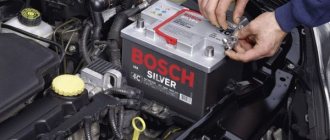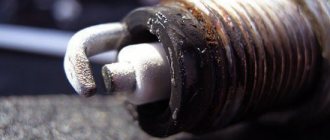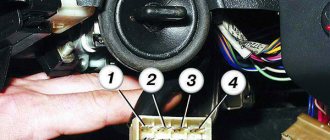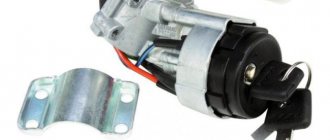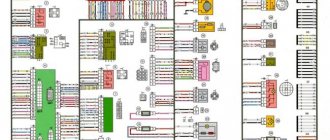To start driving a car, you must first start the engine - every car owner knows this, and even people who are very far from automotive topics. On most cars, the electric charge from the battery is supplied to the starter through the ignition switch contact group. You need to insert the key into the lock, turn it to the first position to turn on the ignition, then to the extreme position. Only then will the starter work. But there are situations when the key does not turn in the ignition. Don't panic. This problem can be solved.
There are several reasons why this annoying malfunction occurs. Let's look at these reasons and repair methods.
Lockout triggered
Any modern car is equipped at the factory with a special steering wheel locking mechanism. This is one of the protective measures that are designed to prevent attackers from stealing a car. If this blocking system has worked, then naturally the key in the lock will not turn, so that it will not be possible to turn on the ignition and start the engine.
VAZ starter does not turn video
The starter in the design of vehicles ensures the start of the power unit. Therefore, when problems arise with starting, most car owners ask themselves: why did the starter stop turning and why does its retractor not click? Despite the fact that the operation of the engine starting device lasts only a few seconds, its breakdown completely paralyzes the operation of the car, since the engine can be started normally only with a pusher, although this is only possible with a manual transmission (manual gearbox), or with the help of a crooked starter (if it is provided for by the design).
You can determine the cause of a malfunction in the engine starting system and troubleshoot problems yourself, especially since this does not require complex diagnostic instruments and tools. But it will be impossible to diagnose the starter’s performance without measuring instruments, the most accessible of which is a multimeter.
When contacts freeze
Russian winters are so severe that in severe frosts the castle also freezes solid. A huge number of situations when the key does not turn in the ignition occur in winter, when temperatures drop below -20 degrees. The thing is that the lock mechanism can accumulate condensation in winter. And then, when the car sits in the cold for a while, these droplets of liquid crystallize, thereby blocking moving parts. As a result, the engine will not be able to start.
The most effective and efficient option is to heat the key with a lighter or a match. The hot element is inserted into the lock and then carefully tried to turn it. If the key does not turn in the ignition the first time (and most often this is what happens), then you need to repeat this operation two or more times.
To prevent the locks from freezing with the onset of cold weather, experts recommend injecting brake fluid into the lock with a syringe and a needle. In the spring, this “well” is thoroughly cleaned with carburetor cleaning fluid. If this is not done, the lock's lubricant will accumulate dust and eventually cause a blockage. This can also cause blocking.
Blockage in the lock
The driver goes outside, opens his car, inserts the key and feels that the key does not turn in the ignition, and it is no longer winter outside. It happens that wells become clogged. During operation, a large amount of various debris easily gets into them. Dirt actively collects (especially if the mechanism has been lubricated with thick lubricants or oils to improve operation).
Ideally, you need to disassemble and thoroughly clean the lock. But this is not always possible. Experienced drivers, in order to continue operating the car without visiting a service station, solve the problem with the universal remedy WD-40.
The starter does not turn, but the solenoid relay clicks
In this case, the first thing you need to do is check the battery charge level and the quality of the contacts. If the battery is discharged, it may have enough charge to operate the retractor, but not enough to crank the engine. The same goes for contacts. Not enough energy will flow through a poor contact to operate the starter.
You also need to check the solenoid relay. To do this, it can simply be excluded from the circuit. Take a strong screwdriver and close the 2 large contacts on the solenoid relay. If the starter starts to turn, then the relay needs to be replaced with a new one.
It could also be a physical breakdown of the starter itself. Possible winding breakage, gear wear, bendex failure, etc. This will become clear after removing the starter from the car.
These are probably all the main reasons why the starter does not turn . If you know any more, be sure to write about it in the comments.
Wear of contact group surfaces
During the operation of the car, the place where the metal elements come into contact with each other is wiped off. Due to this, the gaps grow. The key itself and the elements of the lock mechanism may become worn out.
In the first case, if the key in the VAZ ignition switch does not turn, visually check the condition of the key. If its teeth are rounded, and its width or length has noticeably decreased, then it should be replaced. For comparison, take a second spare key. But it’s better not to use it on a daily basis. Experienced motorists recommend making a duplicate. If you continue to use the second key, then someday the situation will repeat. And then you will have to change the lock.
It must be said that you can find out about a worn key or lock much earlier than jamming occurs - if the key in the ignition switch does not turn well, then this is the first call. If the key is stuck due to abrasion, you can usually try to find a position where the key can engage the secret part of the lock. To do this, carefully turn and press the key into the lock hole many times.
Fuel system
It happens that the tank simply runs out of gas, do not forget to monitor its level. You also need to pay attention to its quality. Due to low-quality gasoline, spark plugs often flood, the filter becomes dirty, and moisture forms.
If you have filled in with low-quality fuel, then in this case you need to remove the gas tank and change the coarse and fine filters, you can try to blow out the fuel pipes.
If the injectors are dirty, they can be cleaned using any available method. When there is a lot of water in gasoline, you can add a little alcohol to the tank.
But if there are a lot of impurities and dirt, then only strong cleaning will help. You see that the starter is spinning, but the engine refuses to work and you can’t hear the fuel pump pumping. It may fail, there is no tightness in the power system or the pressure regulator is malfunctioning.
The first thing you need to do is check the pressure in the rail, the normal value is 3.5-4 atmospheres .
Then you need to remove the hatch and measure the voltage in the connector; the light bulb can be inserted into the two terminals in the middle and cranked with the starter. It should light up and if the voltage reaches, but there is no pressure, you can try to hit it. The brushes could simply be stuck. If they are normal, then the coarse mesh may be clogged, it needs to be cleaned or replaced; in winter it may freeze up.
If electricity is not supplied, you need to check fuse F21 and relay k12. The relays (power coils) need to be removed, tapped on them a little, or simply warmed thoroughly in the palms of your hands.
Deformations
Often the main cause of problems with the operation of the lock is the key. It is subject to deformation. Damage occurs in various cases (for example, when a car owner opens beer bottles with this key).
Deformations of the lock's secrets occur even more often. This leads to the ignition switch breaking. In this case, only dismantling the lock and removing crumpled springs and slats will help. Often in modern cars, only complete removal of all the lock's secrets helps. After this operation, the car starts even with an ordinary screwdriver. Naturally, if the ignition switch is torn out and the key does not turn, the Mercedes can be easily started even with a Swiss Army knife. This is the only option to get to the service and replace the element.
Trailer for walk-behind tractor: do it yourself, buy used, new, what to choose
With prolonged use, the key may simply break and wear out. Contacts are erased and deformed.
A spare key, which almost everyone always has, will help you here. If you don't have a spare one, you can try restoring the old one. But this is relevant in a situation where it has been bent and deformed. It is impossible to build up erased contacts with your own hands.
It is usually recommended to insert worn keys and try to turn them in different positions and with different forces. There is a chance that you will be able to hit the secret key and the engine will start. But the key needs to be replaced soon.
Other reasons
Sometimes it is much easier to solve a problem, since the reason is very trivial. For example, if on models with automatic transmission the key in the ignition does not turn (“Opel Vectra C”, for example), then you should not exclude a problem with the position of the box. Some car models are designed in such a way that the key cannot be turned until the selector is in neutral or park.
Symptoms of a problem
What are the symptoms of a bad ignition switch? Let's start with the fact that its malfunction can be either mechanical or electrical in nature. In the first case it is:
- lock jamming in one of the positions;
- inability to unlock the steering shaft;
- entering the ignition with a non-original key or other object.
If your lock has an electrical problem, you may notice the following symptoms:
- indicator lamps on the instrument panel do not light up or do not light up and periodically go out;
- the starter does not start;
- some or all electrical appliances whose circuit is powered by the ignition switch (cigarette lighter, headlights, washing machine, windshield wipers, etc.) do not work.).
Renovated or new?
It would seem that what could be simpler than replacement if the key does not turn in the ignition? Whether it’s a Toyota or a domestic VAZ, it doesn’t matter. But it's not that simple. Buying a lock at a salvage site is not suitable for many people, since a used element will be in the same condition and is unlikely to last long.
To start the vehicle moving, you need to start the power unit - both experienced motorists, novice drivers, and those who never drive at all know this. In most cars, the electric charge from the battery is supplied to the starter via a contact group. An appropriate key is required, set it to the first position to start the ignition, and then turn it to the extreme position. Only after these actions does the starter operate. But sometimes the key does not turn in the ignition, and manipulations with it do not bring the desired result . No need to panic. This problem can be solved quite easily .
Principle of operation
The lock works as follows. When the key is inserted into the compartment, its locking mechanism is disabled. This occurs due to the reverse movement of a special rod. When the key is turned to the first position, contacts “15” and “30” will be energized. This will alert (but not enable) the following items:
- ignition system;
- headlights;
- external light signal;
- electrical equipment of the dashboard;
- windshield wipers and washers;
- easier;
- heated rear window;
- generator excitation winding.
If you turn the ignition key to the second position in a VAZ-2114 car, in addition to the listed equipment, the starter will start. As you can see, a lot depends on the serviceability of the device in question.
Castle design
Before answering the question why the key gets stuck in the ignition switch, you need to look at how the locking mechanism works . The basis of all locks is the cylinder. This is an element that determines the privacy category of the device.
The key does not turn in the ignition
In the simplest mechanism, the larva has the shape of a cylinder, which has a different number of diametrical recesses (4-10). Each of them is equipped with its own spring-loaded plate, which, when the original key is fully inserted, sinks to the same level as the cylinder. And this element has the opportunity to rotate freely inside the locking mechanism as long as the activator key is present in it. In turn, the larva is combined with other nodes:
- contact group;
- steering lock device.
Causes of failures and their elimination
There are a number of reasons that provoke this unfortunate misunderstanding. Let's talk in more detail about the reasons and possible options for correcting the situation. Among the most common reasons why the key does not turn in the ignition switch is this:
- activation of the steering lock system;
- freezing of the unit due to negative temperatures;
- lock blockage;
- elementary wear and tear of the device;
- deformation of the lock itself or the activating key.
Next, we’ll talk in more detail about each of the reasons.
Steering wheel lock
Recently, all cars already on the assembly line receive a special element that blocks the steering wheel in the event of an unauthorized attempt to start the engine. When the system is blocked, the key will not turn, so that the power unit will not start when the ignition is turned on.
Ignition key
What should I do if the ignition key does not turn as a result of the lock being activated? In such conditions, professionals advise finding a location for the steering wheel where both the steering unit itself and the locking mechanism are unlocked. This is accomplished by certain actions:
- Place the key in the lock mechanism.
- At the same time, turn the steering wheel in different directions.
This will help set the key to the engine start position. But the main thing is that in one of these positions the lock will be unlocked.
Freezing contacts
In winter we have such severe frosts that the locking mechanism freezes tightly. Most often, situations with difficulty turning the key in the locking mechanism occur precisely in winter , when the temperature drops below -20ºС. This happens because the lock assembly collects condensation. And then, after standing in the cold for a while, the drops freeze, blocking the moving parts. As a result, the engine will not be able to start.
Ignition switch frozen
In such a situation, experts recommend simply warming up the locking mechanism. This can be done with any device that supplies hot air, for example, a hair dryer. It needs to be sent into the well. You should not warm the castle with boiling water or other liquids that crystallize in the cold.
But a more productive option would be to heat the key with an ordinary lighter or matches. The heated key is placed in the hole of the lock and then carefully turned. If you can’t turn it right away (and this often happens), you need to repeat heating several more times.
To prevent the lock from freezing in the cold, professionals advise injecting a little brake fluid into it with a syringe and a needle. With the end of frost, the keyhole is cleaned with a composition for cleaning carburetors, since an “unwashed” mechanism will collect dust, which will ultimately lead to its clogging. Which also provokes blocking of the mechanism.
Lock clogged
Imagine the situation: you get behind the wheel, insert the key and realize that it does not turn, although it is no longer winter outside. Often, the well becomes clogged. A variety of debris accumulates in it . Dirt accumulates intensively, especially if the lock has been treated with a special lubricant or oil for efficient operation.
The ideal option in such circumstances is to disassemble and thoroughly clean the lock. Unfortunately, such actions cannot always be performed. In order to further use the car without visiting a car service center, specialists can solve this problem using the universal tool WD40. The tube from the can is directed into the hole and the composition is poured in until a clear liquid flows out.
Cleaning the ignition switch
Note that this product copes with the most serious stains. But if you fail, you will need to disassemble the lock.
Natural wear and tear
With constant use of the vehicle, the places where metal parts come into contact with each other, they wear out . Therefore, existing gaps increase. The key is worn out, as well as the locking mechanism.
If we talk about VAZ models, then you should conduct a visual check of the key. If its teeth are rounded and its size (width/length) has decreased, then it must be replaced. The 2nd copy is used as a sample. But it is advisable not to use it daily. Masters advise ordering a duplicate. If you constantly use a spare key, the problem will certainly recur. And the lock block will need to be replaced.
Note that it is possible to determine the wear of elements much earlier than a rotation failure occurs. When the key turns with difficulty, this is the 1st signal.
If the key jams due to wear and tear, you can find a position in which the key will be able to catch on the “secrets” of the lock. To do this, you need to carefully turn and press the key into the keyhole several times.
Deformation of elements
Very often, the key itself becomes the cause of difficulties with the lock's operation . It is prone to deformations that occur in various situations. For example, when a driver uses it to open a beer bottle. If the key is bent, you can straighten it using a wooden/rubber hammer. After completing these steps, you need to test the key in operation again.
Deformation of the secrets in the locking mechanism occurs much more often. This leads to the switch being damaged. In such a situation, only removing the lock and removing the deformed elements will save you. Although, more often it only helps to completely dismantle all the secrets of the locking mechanism. After such actions, the vehicle will start even with an ordinary screwdriver. But the best option would be to visit a car service center and replace the element. But not every lock can be removed without completely removing the unit. Often it is even necessary to remove the switch from the steering unit.
During these actions, some difficulties may arise with unscrewing fasteners that have special heads. Therefore, to begin with, the caps are exposed to a hammer and chisel, and then used with pliers.
Other reasons
Often the solution to such a problem is much simpler due to the banality of the cause. For example, in cars with an automatic transmission, you cannot turn the key in the locking mechanism, try looking for the reason in the position of the box. On some models, the key will not turn until the switch is in neutral or park.
Another simple option that can be used in such situations is to lightly tap the key. This will help if the key has difficulty getting into the recesses.
Repair or install a new one
Many people believe that a change is the best option, but this is not entirely true. Buying a disassembled lock is not an option for everyone, since a used device is in a similar technical condition and is unlikely to work for a long time.
Repair or new installation?
In addition, the new keys will not fit the trunk/glove compartment. It will need to be registered in the car (does not apply to our cars). Undoubtedly, you can carefully disassemble the element from the old lock and remove the chip from it, and then put it on the purchased copy.
But the best option is to restore the larvae. This way you can keep the old copy of the keys in use. If it is necessary to cut a new body onto an element, it will be made according to the original characteristics.
Crankshaft sensor
If the starter turns normally, the fuel pump works, the spark plugs and the “brains” are normal, you need to check the sensor.
You need to look at the tachometer; if there is a failure, the revolutions are not visible. You need to remove it and connect it to a multi-meter. You need to quickly wave a screwdriver in front of the sensor.
If there are no power surges, then it has “died” and needs to be replaced.
You can check it by testing the resistance; it should be approximately 750 Ohms.
If jumps are still observed and the resistance is normal, you need to look carefully to see if contamination has appeared and, if necessary, cleaning should be done.
The price of solving the problem
If it is impossible to repair a broken mechanism , you must buy and install a new one. By contacting the official service, you will receive high-quality installation of the original locking mechanism very quickly. Replacing the lock mechanism in the service costs approximately a thousand rubles.
If you want to do this yourself, you first need to buy a lock that matches the model of your car. This affects its cost. Typically, imported components cost from two thousand rubles, Russian ones up to one thousand (for example, for VAZ cars the cost of the mechanism is within 700 rubles).
To prevent breakdowns of the locking device in the future and extend its service life, it is important to regularly lubricate the moving parts. To do this, inject a little oil into the hole with a syringe, and there will be no difficulties with turning the key in the ignition for a long time.
We have analyzed the main reasons for the key “wedges” in the ignition. And they explained how to resolve such difficulties independently.
Every motorist knows perfectly well that it is impossible to start driving a car until the engine is started. And to do this, first insert the key into the ignition switch. When this happens, on most cars the electrical charge from the battery goes to the starter. The ignition switch contact group plays a key role here. The driver inserts the key, turns it in the desired direction, activates the ignition, and then turns it to the extreme position. It is at this moment that the starter should operate. But sometimes it happens that the key does not want to turn. This is a fairly common problem that you can fix yourself. If you do not want to take risks, then it is better to invite a specialist or deliver the car by tow or tow truck to a car repair shop.
Causes
There are several main reasons why the key in the ignition switch does not turn on a car. Depending on the source of the problem, the driver will have to perform certain actions. Practice clearly shows that quite often the problem is not serious, and therefore it takes little time, effort and money to eliminate it. Most often, the key does not want to turn in the ignition switch because:
- The steering column lock is activated;
- nodes freeze due to exposure to low temperatures;
- elements become dirty;
- natural wear and tear is observed;
- the key or other components of the locks are deformed, etc.
Each potential cause must be addressed separately. This will allow the motorist to recognize the malfunction and understand how best to fix it.
Blocking
Car owners often panic and try to figure out what to do if the steering wheel and ignition switch are locked. Such situations are explained by the presence of factory steering lock systems on many cars. This is a fairly common and effective protective measure designed to prevent possible vehicle theft. When this same locking system on the steering column is activated, then it will be impossible to turn the key in the ignition switch. Therefore, the driver is deprived of the opportunity to start the engine and drive. Don’t rush to call for help, call a tow truck and look for a suitable car service. You can try to solve the problem yourself if the car’s steering wheel and the ignition switch itself are locked at the same time. Experienced motorists recommend searching for a suitable steering wheel position. There is a point at which the steering column and lock must unlock. To achieve the desired result, try inserting the key into the lock and simultaneously turning the steering wheel in different directions. Do not do this very quickly so as not to miss the desired position. In most cases, using this method, you can fully insert the key into the ignition, turn it and start the engine. If this is factory protection from the car manufacturer, then if the position is correct, unlocking will occur. You just need to find it.
Exposure to low temperature
In some regions, winter is accompanied by severe frosts, which can easily cause the key to stubbornly refuse to turn in the ignition. Most often, this can be observed in situations where the air temperature drops below -20 degrees Celsius. Gradually, as it is used, a certain amount of moisture in the form of condensation may accumulate inside the ignition switch. When the car sits in the cold for some time, the process of crystallization of water droplets begins. As a result, frozen water blocks the moving elements of the ignition switch. Because of this, the motorist cannot start the engine and drive. The simplest and most effective solution in such circumstances would be to heat the castle. You can use any suitable available means for these purposes. The most convenient way is to use a household hair dryer, directing a stream of hot air to the center of the ignition switch of your car. But it is better to avoid using any hot liquids that freeze at subzero temperatures. This is especially true for hot water. This can only make the problem worse, because the next time you stop for a long time in the cold, there will be even more ice inside the castle.
If you don’t have a hairdryer at hand, which is quite logical when you’re not near the house, then take matches or a lighter. Carefully light them and bring the fire to the key. Gradually heat it up and insert it into the lock. The heat emanating from a match or lighter should be transferred to the metal of the key and melt the formed water crystals, thereby opening access to starting the engine. Be prepared for the fact that during the first heating the key will not be able to be fully inserted and turned the first time. The procedure should be repeated several times. But even if you are in a hurry, never bring an open flame to the lock itself. You can melt the plastic parts and create additional problems for yourself. But it’s definitely not an option to come to the car every day with a hairdryer or keep a supply of lighters in your pocket throughout the winter. Therefore, an effective solution to the problem of freezing of the ignition switch at low temperatures is proposed. When cold weather sets in, you can protect the castle from possible freezing for the entire winter period. This requires a regular medical syringe with a needle. Using a simple tool, you need to inject a small amount of brake fluid into the lock. It will prevent condensation from freezing, even if it appears there.
But remember that after the temperature rises in the spring, the lock must be cleaned. To do this, use carburetor flushing. If you forget to carry out this procedure, the lubricant will become a source of dust and dirt accumulation. As a result, you will encounter another reason for the ignition switch being stuck, which is related to blockages.
Clogging
Even if it’s warm outside, there is no frozen condensation in the lock and everything is fine with the locking, when you try to insert and turn the key to start the engine, nothing happens. Something is blocking the ignition from working properly. This is often caused by accumulated dirt. When the machine is operated for a long time, dust, dirt and other small debris accumulate in the well through the key itself and in other ways. At first it does not interfere at all, but as it increases in volume it can cause a similar problem when the key does not want to turn. This situation can be observed especially often in those cars where thick materials were used to lubricate the mechanisms. They are sticky and therefore easily attract debris.
FakeHeader
Comments 20
I’ve been suffering from the same nonsense for three months now. I wanted to change the lock; the bolts are screwed out, but I don’t know how to change the ignition switch.
the bolts need to be knocked out (tapping carefully) or removed with the steering column =))) try until thawed, hammer with graphite,
The lock has changed everything. He took a chisel and quietly tapped the heads. And so he unscrewed all the bolts.
exactly the same nonsense happened a couple of years ago, I sprayed everything there, even hammered graphite into the keyhole, no effect in the end, I took the lock apart (if you take it apart, be more careful, there is a ball with a spring - it will fly out and you won’t find it) and with Using a small file, I slightly rounded all the corners, lightly greased them with graphite, and this problem went away
It’s scary to imagine what happens in the mind of an ordinary driver when the steering wheel suddenly jams while driving. Why did some owners of front-wheel drive Ladas equipped with an alarm system with auto start find themselves in such an extreme situation? As it turned out, this was due to a feature of the ignition switch, which AVTOVAZ specialists refused to consider as a defect and advised drivers to turn the key to the fixed “ignition” position.
LADA > Kalina
LADA > Priora
The first similar messages appeared on owner forums back in early 2008. They mainly concerned Kalina, but Priora and Samara were also mentioned. While driving, the steering wheel of some cars spontaneously jammed, and drivers had to make great efforts to avoid serious accidents.

